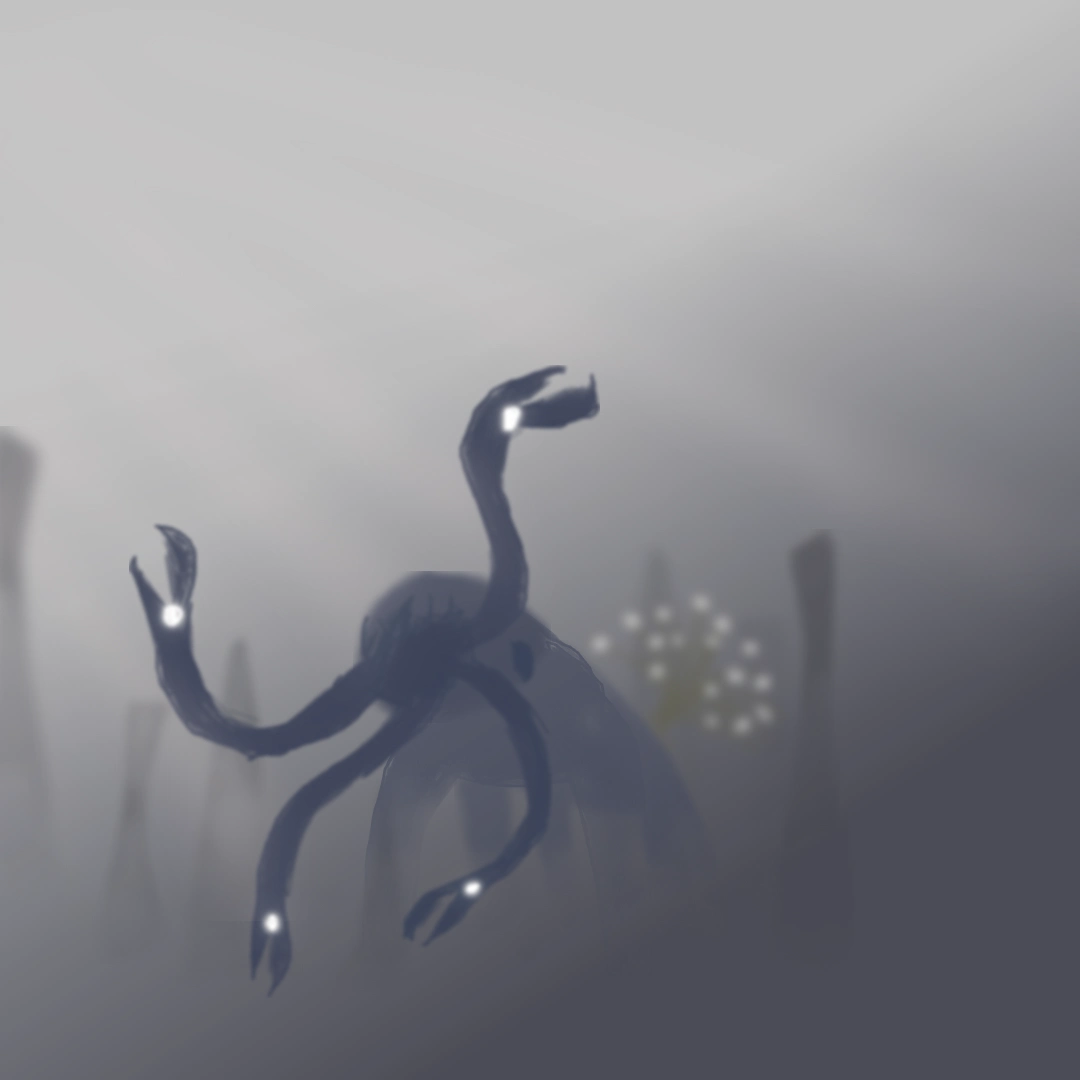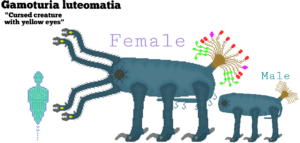
The massive depressions that were once home to Nibbio‘s oceans now serve as vast swamps perpetually covered in mist. Because of high humidity and atmospheric pressure, the environment can feel tropical in an otherwise cold planet.
If one were to step foot in these, swamps, they would find essentially expanses of decomposing high-growth organic matter, swamps shallow and hypersaline, remnants of ancient oceans, and endless plains of mud and algae. In essence, it is a hyperproductive ecosystem, with the base of the food chain made up of algae and decaying plant matter.
Since the oceans have evaporated, one might think that their marine life forms have become extinct, but this is not the case. As the oceans sank, many creatures evolved a series of glands to expel excess salt, and hyper-efficient kidney-like organs, along with gill structures that allow them to breathe super-humid air in a similar way to how Earth octopuses or certain crabs do.
For this reason, in this swamp you can encounter animals similar to basal tetrapods, with tiktaalik-like fish that graze on the algae and large fish similar to mudskippers that move between one plant and another in a sort of parody of monkeys, using fins hyper-elongated for gliding and denticle-like growths under their paws for climbing. However, other creatures lurk in these marshy expanses, belonging to a phylum opposite to that which inhabits the upper continents.
Equipped with facial tentacles, the number of which varies depending on the species or order, eyes that see in shades of ultraviolet, blood-based on proteins and enzymes, and external brachiae similar to parasitic anemones, the hydras are a terrifying presence to behold.
Hydras descend from sea animals similar to Earth sea cucumbers and have taken over marshy expanses thanks to some particular characteristics. Marine ancestors were benthic, and as such, already had limbs for locomotion, unlike fish-like life forms. Moreover, they already possessed an iron-based internal skeleton that supported them and protected them from overwhelming underwater pressure.
Their respiratory system is based on enormous external gills specialized in osmotic exchanges even in environments with low oxygen concentrations, such as the seabed full of decaying matter typical of a superearth. There are various reasons why life forms, especially sessile or vegetal ones, live less on a super-earth, and the most pressing of these is the immense mass of bacteria. The bacteria biomass on a super-earth such as Nibbio can be tens of thousands denser than on a planet like Earth, and even the slightest wound has a very high percentage of becoming infected and going into necrosis, leading to the death of the animal.
While animal life forms can rely on increasingly specialized and efficient antibodies, plant life forms can rarely rely on anything better than the normal acidification of tissues in relation to the bacterial mole, so they tend to live less and reproduce more. Hydras are born parthenogenically in a larval form, without external gills but capable of cuticular osmotic exchanges, and specialized in feeding on decomposing, or in rare cases even living, vegetal or animal matter. To feed on decaying things they have developed highly efficient gastric acids, even superior to those of a vulture, and the ability to secrete disinfectant enzymes.
This lifestyle based on niche partitioning, combined with the development of immense salt marshes, has, among other characteristics, favored their development as dominant life forms, although they would never be able to breathe on continental surfaces given that the fog, and consequently the humidity they require, is less saturated there than those found in swamps.
Over the eons, the hydras have specialized in dozens of orders and hundreds of families, some developing two sexes, others developing flight, still others returning to the few remaining bodies of water, no more than large lakes, others adapting to reproduction via live birth, while others have stopped feeding on the decomposed matter and developed solid-shelled eggs. It was probably the largest adaptive radiation ever to have occurred on Nibbio since the first complex life forms were born in the now-evaporated seas of the planet.
Vrachiopragids are some of the most colorful hydras on the planet, using bio-lights systems to communicate with each other instead of sound like most other hydras. They are predators, but despite this, they are pachydrids and therefore evolutionarily closer to bovid-like forms than to true predatory forms. In some respects, they could be compared to carnivorous bison.
Descended from pachydrids, they still have a larval form that requires biological matter external to the maternal body to grow, but they have completely eliminated the egg phase in favor of a reproduction mechanism similar to the katoikogenic gestation of some types of terrestrial scorpions. They still have an ovipositor, which is however used to inject the larvae into dead or living biological matter. Reproduction is parthenogenic most of the time, but every ten years, in a mechanism that seems global among parthenogenic hydras, male larvae are produced to increase the gene pool. The male is totally different from the female in many characteristics. When it enters the subadult imago, i.e. a small version of the sexually mature adult, it is smaller than the female and lacks photophores. It will spend most of its time eating until, once it becomes sexually mature, it loses its tentacles, the stomach atrophies, and the oral cavity consequently becomes useless. The organism begins to metabolize the accumulated fat and the males search for mates, favoring females with the brightest and largest photophores.
After mating, it is devoured, so that the proteins it was composed can be used to form the molecular base of the larvae.
The yellow-eyed inseminator hydra is a large solitary predator of northern marshes, which feeds on medium-sized fauna that it incapacitates thanks to venomous secretions injected through its tentacular pincers, with occasional small prey collected in the waters, sometimes sifting through decaying matter in search of other hydra larvae.
The male, unlike the female, will feed exclusively on small animals and carcasses in another example of niche partitioning.

They possess a neurotoxic venom, which causes convulsion-like spasms in the prey and general degeneration of the nervous system, thus leading to death.
The larvae need animal flesh, but not decaying ones. Various species of hydras have in fact developed parasitic relationships similar to those present between some species of Earth wasps and caterpillars. The female will hunt herbivorous animals of similar size to her own for her larvae, paralyzing them with her venom.
Once the prey has been secured, it will insert its larva into its abdomen. From here the larvae will burrow into the animal’s flesh and eat it from the inside alive. A premature death would be averted by voluntarily avoiding the vital organs and exploiting the ancestral secretion of disinfectant enzymes to prevent the wounds (real tunnels in the host’s body) from going into necrosis. They pupate in cavities close to the skin, and, once the bones and the smaller adult form have formed, they emerge from their pupa and pierce the host’s skin, killing it. Often the animal is already dead when they emerge, either because the larvae have devoured too many muscles to allow it to move, thus causing it to die of starvation, or because it has not been able to bear the extreme pain of a thirty or more animals slowly its body from the inside.
This entry was made by Zarekay56